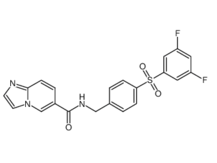
GNE-617
CAS No. 1362154-70-8
GNE-617( GNE-617 | GNE 617 | GNE617 )
Catalog No. M17972 CAS No. 1362154-70-8
GNE-617, a specific NAMPT inhibitor(IC50=5 nM), shows potency in xenograft models of cancer.
Purity : >98% (HPLC)
 COA
COA
 Datasheet
Datasheet
 HNMR
HNMR
 HPLC
HPLC
 MSDS
MSDS
 Handing Instructions
Handing Instructions
| Size | Price / USD | Stock | Quantity |
| 2MG | 43 | In Stock |


|
| 5MG | 69 | In Stock |


|
| 10MG | 113 | In Stock |


|
| 25MG | 207 | In Stock |


|
| 50MG | 332 | In Stock |


|
| 100MG | 494 | In Stock |


|
| 500MG | 1071 | In Stock |


|
| 1G | Get Quote | In Stock |


|
Biological Information
-
Product NameGNE-617
-
NoteResearch use only, not for human use.
-
Brief DescriptionGNE-617, a specific NAMPT inhibitor(IC50=5 nM), shows potency in xenograft models of cancer.
-
DescriptionGNE-617 is a potent nicotinamide phosphoribosyltransferase (NAMPT) inhibitor with IC50 value of 5nM. Prolonged inhibition of nicotinamide phosphoribosyltransferase (NAMPT) is a strategy for targeting cancer metabolism.
-
In Vitro——
-
In Vivo——
-
SynonymsGNE-617 | GNE 617 | GNE617
-
PathwayMAPK/ERK Signaling
-
TargetJNK
-
RecptorNAMPT
-
Research AreaMetabolic Disease
-
Indication——
Chemical Information
-
CAS Number1362154-70-8
-
Formula Weight427.43
-
Molecular FormulaC21H15F2N3O3S
-
Purity>98% (HPLC)
-
SolubilityDMSO : ≥ 42.85 mg/mL; 100.25 mM
-
SMILESC1=CC(=CC=C1CNC(=O)C2=CN3C=CN=C3C=C2)S(=O)(=O)C4=CC(=CC(=C4)F)F
-
Chemical NameN-(4-((3,5-difluorophenyl)sulfonyl)benzyl)imidazo[1,2-a]pyridine-6-carboxamide
Shipping & Storage Information
-
Storage(-20℃)
-
ShippingWith Ice Pack
-
Stability≥ 2 years
Reference
1.Shames DS, et al. Loss of NAPRT1 Expression by Tumor-specific Promoter Methylation Provides a Novel Predictive Biomarker for NAMPT Inhibitors. Clin Cancer Res. 2013 Dec 15;19(24):6912-23.
molnova catalog



related products
-
SU3327
SU3327 is a potent, selective and substrate-competitive inhibitor of JNK(IC50 of 0.7 μM).
-
D-JNKI-1
A cell-permeable peptide inhibitor of JNK kinase.
-
JNK-IN-11
JNK-IN-11 (compound 1) is a potent inhibitor of JNK, with IC50 values of 2.2 μM, 21.4 μM, and 1.8 μM for JNK1, JNK2, and JNK3, respectively, showing potential for Alzheimer's and Parkinson's disease research.



 Cart
Cart
 sales@molnova.com
sales@molnova.com


